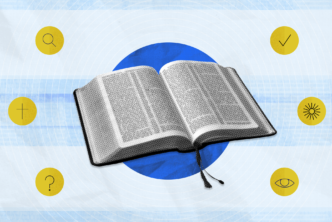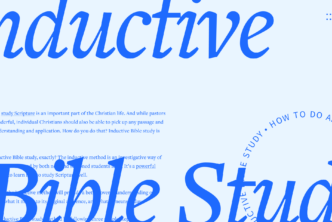“Measure twice, cut once.”
It’s a memorable adage, and good advice with application beyond carpentry. But after measuring and cutting for years, you may be tempted to cut the measuring frequency in half. After all, you’re an expert.
But even experts make careless mistakes.
The same goes for Bible study. Whether you’ve been studying Scripture in-depth for decades or are just getting started, there are a few basic bible study techniques that are worth developing—or redeveloping. And if your Bible study has gone dry or you find yourself struggling to know what to do next, it may mean that it’s time to get back to basics.
Here are five basic Bible study techniques that will help you cut to the heart of any Bible passage.
Observe, observe, observe, observe, observe (then observe some more)
In Grasping God’s Word, authors Duvall and Hays tell the story of nineteenth-century scientist and professor Jean Louis Rodolphe Agassiz.
A new student comes to Agassiz to begin his scientific education. Agassiz plops a fish in front of the student, tells him to note his observations, and leaves. A half hour passes, then an hour, then three. For the rest of the day, Agassiz leaves the student alone with the fish until boredom gives way to actual work. When the student at last reports his findings, Agassiz is underwhelmed. For three long days, he insists the student analyze the fish until all possible observations have been exhausted—from the symmetry of its organs and the number of its scales to the sharpness of its teeth.

Duvall and Hays explain how this applies to Bible study:
Read the Bible carefully. . . Observe! Look for some more! Observe some more. Look again. Ask questions of the text. Look again. See more. Dig! Make notes. Mark the observations you see. Reread the passage. Look for other details. There is more! Keep digging! You get the idea.
To make sure you’re being thorough with your observations, it’s a good idea to save all the notes you’ve taken on a passage and keep them handy for the next time you give it a look. That way you can build on all the work you’ve already done, rather than starting the process over. The free Logos Bible app automatically ties your study notes to the text you’re studying, so the next time you open the passage, all the observations you made are ready and waiting.
We study the Bible because we believe God’s Word has transformational power. We long to apply the principles God has laid out in those pages to our day-to-day life. But if we skip over the observation stage, or cut it short, we risk missing the very principles we’ve come to the text to uncover.
Ask the obvious
When you’re furiously making those observations, don’t forget to ask the obvious. In fact, it’s smart to begin with six little questions you first heard about in elementary school: Who? What? When? Why? Where? How?
This advice is old, but good. Consider the words of Anglican Reformer Myles Coverdale (1499–1569), who wrote in the prologue to his English Bible translation (a precursor of the King James Version):
Again, it shall greatly help thee to understand scripture, if thou mark not only what is spoken or written, but of whom, and unto whom, with what words, at what time, where, to what intent, with what circumstance, considering what goeth before, and what followeth after.
And once you’ve made all of your observations, Peter Krol encourages asking questions about the observations themselves:
Take your observations and ask questions of them. Lots of questions. Tackle those observations from every direction.
Be as inquisitive as possible. Get better at asking questions, and you’ll get better at interpreting the Bible.
Note that your questions should be about your observations of the text. Don’t ask just any old questions. Don’t feel the need to be particularly clever. Your job is not to innovate, but to uncover.
For instance, let’s say you’re studying Romans 12:1–2. In this passage, Paul commands his readers:
Do not conform any longer to the pattern of this world, but be transformed by the renewing of your mind.
In the observation stage of your study, you may note that the first part of the command, “Do not conform,” is active—Paul’s readers are the subject of the verb “conform.” But in the second half of this injunction, “but be transformed,” Paul’s readers are objects of the verb “transform.” Passive.
After making such an observation, ask the question: why? Why are Paul’s readers the subject of the first verb but the object of the second? If they are receiving the action in the second half of this command, who is performing the action? How is this transformation accomplished? Simply by asking questions about the observations you’ve already made, you’re well on your way to uncovering the key idea Paul is getting at in the passage.
Compare Bible translations
It’s unfortunate that for many Christians, the subject of Bible translation has become a battleground. We needn’t fear (and should not ignore!) translations used by other pockets of evangelicalism. When used properly, they’re one of our best allies in Bible study.
Dr. Mark Ward has championed the use of multiple English translations on this blog numerous times. Why is comparing multiple Bible translations so powerful? Because Greek and Hebrew and Aramaic aren’t secret code, they’re languages. (The ESV translation committee do not have Greek and Hebrew decoder rings.) Even if you don’t know Greek or Hebrew, by comparing multiple translations you can begin to uncover a sense of the original languages—nuances you’d otherwise miss. Mark explains:
If you’re willing to step out of your comfort zone and pick up a Bible translation you formerly avoided, something wonderful might happen: You might learn something! As soon as you see the interpretive rendering in the NIV or NLT, something may click for you: you might see meaning you never knew was there. Or as soon as you see the way a more literal translation of 1 Corinthians 7, you may realize that the interpretation of “virgin he is engaged to” (NIV) you’ve assumed all your life is really a more complicated issue than you realized. That might force you to dig deeper in your study. And what is the harm in this?
The Logos Bible app makes comparing any translation much simpler. You can set it up in seconds, then identify differences between translations in just a glance.
Write out the passage and rephrase it in your own words
Studies have shown that writing something out by hand engages multiple regions of your brain. Perhaps that’s why John Piper finds writing a passage out in longhand so effective:
I do this with almost every sermon I preach. I don’t fully understand it, but there are ‘eyes’ in my pen. I see things when I slowly write the text. I see things that I see no other way.
I’m faster at typing than I am at writing by hand, and so I’ve found writing out a passage in longhand forces me to slow down and soak in its meaning. And after reading a passage multiple times, writing it out solidifies its words in my memory. I carry the passage with me throughout the day; my subconscious works it over and I discover more opportunities for meditation.
After you’re done writing out the passage, consider this recommendation from The Navigators:
Starting with the first chapter, write out each verse or section of verses in your own words. This will help you understand each verse in wording that makes more sense to you.
Here is an example using 1 Timothy 1:1
Original Verse:
“Paul, an apostle of Christ Jesus by the command of God our Savior and of Christ Jesus our hope . . . ” (1 Timothy 1:1 NIV).
Personal Paraphrase:
Paul, a proclaimer of Jesus Christ, obeying the instructions of God who is the One who saves us, and of Jesus Christ who is our hope . . .
Mark up your Bible
A few years ago, Ray Ortlund offered a complete lesson on how to study the Bible by means of a single picture:
Whether you use a physical Bible or free Bible software like Logos, don’t hesitate to mark up the text. Circle, underline, highlight, bracket, scribble. In the post cited earlier, John Piper says this is exactly what he does:
Another advantage of writing it out is that I can circle words that are repeated. I can underline phrases and draw lines between them. This helps me see connections in the passage. And connections are the key to meaning.
Consider developing your own system for highlighting and markup. The Logos Bible app gives you lots of options to vary your notations—including Kay Arthur’s inductive Bible study system and John Piper’s Look at the Book method. And if you really want to level up your Bible nerd cred, let Mark Ward teach you his own system for highlighting.
Get back to basics with the free Bible app
For 25 years, pastors and ministry leaders have relied on Logos to provide transformational insight in their study. With the Logos app, biblical insights are within reach of anybody with a hunger for God’s Word. Build a bible study habit with digital tools and books you can use anywhere, and master your Bible study technique with built-in training.
Get the Logos Bible app for free!
Related article
All about Hermeneutics: A Complete Guide to Interpreting God’s Word Faithfully







